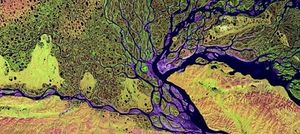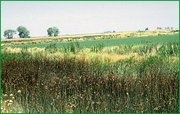Sacramento–San Joaquin River Delta Basin
Contents
Lithology and Stratigraphy
The Sacramento–San Joaquin River Delta basin subsection contains late Quaternary alluvium. Most of the alluvium is from granitic rock sources, but some is from volcanic, sedimentary, and metamorphic rock sources.
Geomorphology
This subsection is a nearly level plain. It is the deltas of the Cosumnes, Mokelumne, and Calaveras Rivers and basin floor with basin-fill from the overflow of these and the Sacramento and San Joaquin Rivers. The subsection elevation range is from sea-level to about 50 feet. Fluvial erosion and deposition are the main geomorphic processes.
Soils
The soils are mostly Aquic Xerofluvents; Pelloxererts; Cumulic and Duric Haplaquolls; Argic Durixerolls; Typic Durixerolls; and Chromoxererts. The soils are mostly somewhat poorly to poorly drained, and some are moderately well drained. Soil temperature regimes are thermic, and soil moisture regimes are mostly aquic and xeric.
Vegetation
The predominant natural plant communities are Needlegrass grasslands, Emergent aquatic communities in low areas along the edge to the delta, and Fremont cottonwood series along streams.
Characteristic series by lifeform include:
Climate
The mean annual precipitation is about 16 to 18 inches. It is practically all rain. Mean annual temperature is about 59° to 62° F. The mean freeze-free period is about 250 to 275 days.
Surface Water
Streams in this subsection drain to the delta area of the Sacramento and San Joaquin Rivers. All but the larger streams are generally dry during the summer. There are no lakes.

